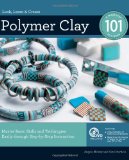Polymer Clay 101

It's finally here! Polymer Clay 101
is now in stock at various bookstores online (more on where to buy it below). I co-wrote Polymer Clay 101 with Kim Otterbein: she wrote the basics chapter and the first 11 projects, while I did the last 10 projects and "starred" in the accompanying DVD.
Book-writing is so much more solitary than blog-posting — there's a lot of hours of work and a lot of waiting without feedback. So I'm excited that I finally get to show you what I've been up to & see what you think!
Book Overview
Polymer Clay 101 would be great for a polymer clay beginner. The first 33 pages cover all the basics — tools, techniques, color mixing, mold making, sanding & polishing, etc. After that, 21 projects demonstrate major polymer clay techniques. We show how to do important things like Skinner blends and caning... but we also show some more unusual techniques like using an extruder for a filigree look, and carving baked clay. The 45-minute DVD shows each of these techniques in action — great for visual learners!
My Review
(Just kidding!) I'm a little too close to this material to do a review. However, I've read quite a few polymer clay books for reviews on this site, and here are a few things that I think (hope) make this book stand out:
- The photos. They're big and clear. They show exactly how to do each step.
- The binding. It may just be me, but I think all craft books (and all cookbooks) should have a spiral binding. It makes it so easy to keep the book open to the appropriate page while you're working through a project.
- The DVD. While photos are very helpful for visual learners, sometimes watching it "live" is the best way to really understand what's going on. This professionally-shot DVD demonstrates each of the book's techniques in a very clear way. (The fact that you get a book and DVD for one price also makes this a great value!)
- The material covered. There's something here for everyone: several jewelry & accessory projects (including buttons!), some home decor projects (like handles for your silverware), and quite a few gift-y items (journal covers, business card cases, and even a magnetic Tic-Tac-Toe game). While I think the beginning clayer will be able to follow the instructions, video, and large step-by-step photos, I believe the intermediate clayer will also find some new and interesting things in this book. And it includes some materials you may not have used with polymer clay before — things like fabric, Amazing Mold Putty, and Magic Glos UV Resin.
But enough of what I think... I want to know what you think! Amazon reviews are especially appreciated. Blog posts, too (contact me & I'll link to your review). But blog post comments and emails are also welcome. While I may be slow at giving individual responses, I will try to keep the website updated with frequently asked questions.
The Website
Speaking of the website... I've set up a new website for the Polymer Clay 101 book. There's lots of info, including a video preview, FAQ and Errata page, links to polymer clay suppliers, and links to reviews. I also created a Flickr group where you can upload photos of book-inspired projects you've made.
Where To Buy
While the publisher plans to have it available in some brick-and-mortar bookstores, I don't know a good way to see whether it's actually in stock yet. (Found it in your local bookstore? Your reports are welcome in the comments below!) But here are a few places you can buy it online:
- Amazon
has the book in stock.
- Polka Dot Creations has it, too.
- If you want a signed copy, I have a limited quantity of books on order.
- I list a couple of other online stores on my Buy It Now page, or you can always search for it (and request it if it's not available) at your favorite bookstore. Borders even offers free shipping for items that are available online but not in stock at your local store.
A Giveaway
Craftside has a free chapter from the book in their write-up. They're also giving away a copy of the book. (Sorry, giveaway ended midnight 12/21/10.) I'll be giving away a copy here, too — though I'll probably wait until after the holidays.
Finally...
Thank you for all your friendship and support. Make sure you read the acknowledgments, because I'm talking about you! :-)

